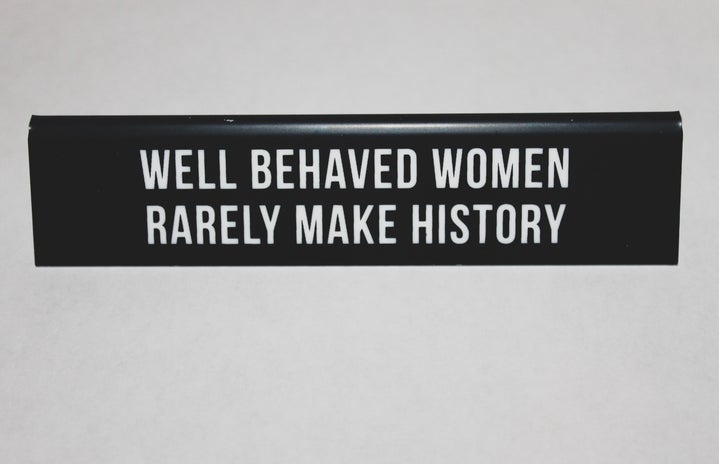When I arose from my warm slumber at 3:15 am on January 21st, a chilly Saturday morning, I had a moment of hesitation in which I contemplated the various ways the day could go. On one hand, I could go back to sleep, skipping the bus ride to DC and the Women’s March, and any of the chaos and stress that went with such a vocal and passionate event. But getting up and getting on that bus could also be my opportunity to experience a prominent, historic event, to voice my opinion, and to be inspired by so many powerful women. I didn’t go back to bed. Instead, I stumbled into my jeans, Mount Holyoke shirt, and sneakers (arch support, ya know?) and was driven to my local train station by my sleepy brother. There I entered the bus, chartered by a local synagogue that my aunt is a part of. She had reserved a seat for me on the bus and accompanied me as well as a few other family members and friends, most of whom I did not know.
The ride to DC from Long Island was a good 5 hours. In the darkness, our nervous bodies found a few more light hours of sleep, cramped in our seats, our knees pulled up and heads leaning against cold windows. When the sun rose, a thick fog hung over Maryland, and bus passengers awoke as well, feeling about as foggy as the sky looked. As we inched closer to our destination, I listened to the people around me prepare for the day. They were an oddball combination of mothers, daughters, and friends. Men and women of various ages were prepared to stand up for women’s rights. I was already feeling inspired. What had been predicted to be a march of around 200,000 people quickly proved to have swelled multiple times its expected size. People streamed across the national mall waving signs and chanting in unison. The rally area, which featured various speakers including feminist activist Gloria Steinem, Planned Parenthood president Cecile Richards, and author/activist Janet Mock, was packed with marchers, most too far away from the stage to even hear. The aptly named Women’s March, often portrayed as an anti-President Trump rally due to it being scheduled the day after the inauguration, was actually thought of as pro women and marginalized groups. It was not intended to directly oppose President Trump, but rather to support women’s issues, such as a woman’s right to choose and equal pay, as well as broader issues such as public education and immigration reform. Nevertheless, the timing of the event, as well as some of President Trump’s controversial statements certainly fueled an anti-Trump sentiment at the March, although it did not dominate the day. At least for me personally, the March was about showing my support for issues I cared about, and for oppressed people. Although it is true that President Trump and his cabinet have acted unfavorably towards women’s rights, as well as many oppressed groups, I was determined to remain positive, pro and not anti. As we pushed through the crowds of marchers and proudly strolled down the streets of DC chanting and cheering, I saw a variety of faces. An overwhelming number of participants were white women, but a fair share of men, women, and children of all different ages, races, and orientations had come out to march as well. Casey Linenberg ‘19 remarked that her hometown of Detroit also saw “mostly women, but some men and children as well.” Linenberg also noticed that many were first-time marchers, perhaps a sign that many people felt the need to mobilize following the election. Victoria Parrish ’19, who attended the New York City march, remarked that “the march did have a ton of people from all walks of life” and that she saw “a lot of families, surprisingly, with young children.”
(Casey Linenberg and a friend in Detroit)
Nevertheless, all these people had come out to fight for their rights. To fight for the rights of others. Fighting for those that could not fight for themselves. Arms proudly waved signs in the air boasting messages such as “My body, my choice” or Hillary Clinton’s “Women’s rights are human rights.” Other signs supported Black Lives Matter, immigrant rights, and public education. Many others ridiculed Trump for his behavior, disagreeable declarations, and his cozy relationship with Putin. Linenberg remarked that she “liked being around people with similar beliefs in equality and critiques of the GOP’s policies” and that “it was reassuring to be in an anti-Trump space when [her] home state voted for Trump in the election.”
Marching in Seneca Falls, New York, Aidan Camera ’20 recalled, “It was very emotional to be in the birthplace of women’s rights. So many people who came before us fought so that we wouldn’t have to. The fact that we still have to fight for women’s rights is very difficult to experience, because it feels like we’re taking a step back.”
Still, the marches did not have the air of angry protests. Instead they had the hope of Americans all over the country refusing to remain quiet. Of Americans wanting to show that marginalized groups’ rights mattered. Wanting the new president to under no circumstances forget that we are here and here to stay. The overwhelming majority of the country wanted progress, equality, and empathy.
(My aunt and I in Washington DC)
When speaking of the NYC march, Parrish notes, “It was a very warm and safe feeling. I felt a great strength of community and a bond with the people who marched. My favourite sign was held by a little girl, maybe 7. She made this sign herself using a shoe box and a paper towel roll. It was written in crayon and said, ‘I just want a nicer president.’ I loved that. I think, bottom line, that’s what we all want. We want a nicer president, who supports nice politics, who appoints nice people, who encourages niceness and love. I mean, our president is the face of our nation, and if he is all of the things that he is, what does that say about our nation and everyone in it? It says we’re not very nice.” As we made our way back to the bus at the end of the day, the city had a remarkable air about it. Despite the bustle of the two days that DC’s streets had seen, no litter was found on the sidewalks. No smashed windows or signs of violence. Security remarked what a relatively easy day it had been. Marchers had chosen hope, positivity, and progress over anger, violence, and destruction. What had been scheduled in DC sprung up in cities across the country and around the world, with estimates of 5 million marchers in all. Hundreds of thousands of marchers showed up across the country, and around the world, with locations as far as Kenya and Antarctica. What had been predicted as a March of 200,000 people became a march of millions.
If you would like to write for Her Campus Mount Holyoke, or if you have any questions or comments for us, please email mt-holyoke@hercampus.com.


